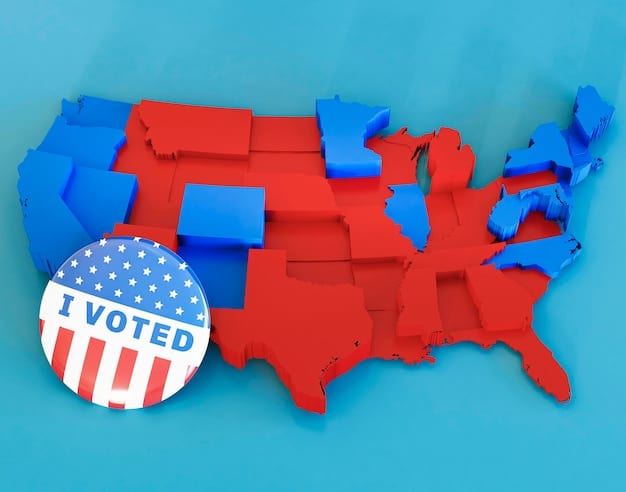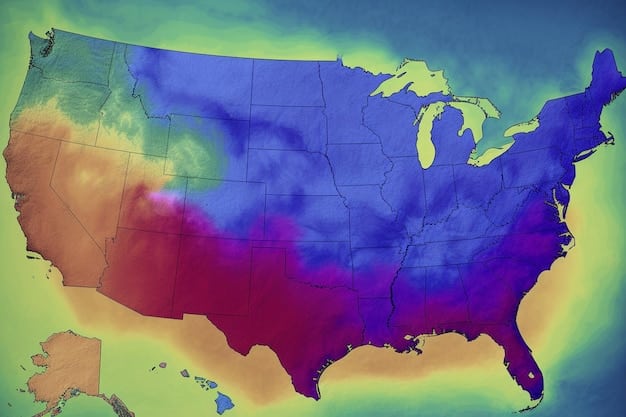Analyzing the Impact of 2024 Redistricting on US Voter Representation

The Impact of Redistricting on Voter Representation: An Analysis of the 2024 Changes examines how the redrawing of electoral district boundaries affects voter equity, political power, and demographic representation across the United States, highlighting the resulting shifts in political landscapes.
The redrawing of electoral maps, known as redistricting, is a process that occurs every ten years in the United States, following the completion of the census. The Impact of Redistricting on Voter Representation: An Analysis of the 2024 Changes is a crucial topic, because how these lines are drawn can significantly influence the balance of political power and the degree to which different communities are fairly represented.
Understanding the Basics of Redistricting
Redistricting is more than just redrawing lines on a map. It’s a complex process with deep political and social implications. The way districts are shaped can either safeguard the principles of fair representation or undermine them.
The Legal Framework of Redistricting
The primary legal guideline for redistricting is that districts must be roughly equal in population. This stems from the principle of “one person, one vote,” as established by the Supreme Court. However, beyond this, states have some flexibility in how they draw their maps, which can lead to significant variations.
Who is Responsible for Redistricting?
The responsibility for redistricting varies by state. In some states, it’s done by the state legislature, meaning politicians get to draw their own district lines. In others, independent commissions are tasked with the job, aiming to reduce political influence.

Ultimately, understanding the legal framework and the actors involved is essential to grasp **the impact of redistricting.**
- Ensuring Equal Population: Districts must have roughly the same number of people.
- Compliance with the Voting Rights Act: Protects minority voting rights.
- Contiguity: Districts should be single, unbroken shapes.
- Compactness: Districts should be as geometrically compact as possible.
Redistricting is thus a complex balancing act between legal requirements, demographic considerations, and political realities.
The Controversy of Gerrymandering
Gerrymandering is one of the most controversial aspects of redistricting. It involves drawing district lines to favor one political party or group over another. This practice can distort the will of the voters and lead to outcomes that don’t reflect the overall population’s preferences.
Types of Gerrymandering
There are two primary techniques in gerrymandering: “cracking” and “packing.” Cracking involves spreading voters of one party across multiple districts to dilute their influence, while packing concentrates voters of one party into a single district to reduce their impact elsewhere.
The Impact on Elections
Gerrymandering can make elections less competitive, entrenching incumbents and reducing the incentive for politicians to respond to the needs of their constituents. It also contributes to political polarization, as politicians become more accountable to their base voters than to the broader electorate.
Gerrymandering shapes the very landscape of elections and, consequentially, the dynamics of representation.
- Reduced Competition: Gerrymandering often creates safe seats.
- Increased Polarization: Politicians cater to specific voter bases.
- Disenfranchisement: Voters feel their votes don’t matter.
Addressing gerrymandering requires reforms such as independent redistricting commissions and clear, enforceable standards for drawing district lines.
Demographic Shifts and Redistricting
Demographic changes in the U.S. have a significant impact on redistricting. As populations shift, states gain or lose congressional seats, and district lines must be redrawn to reflect these changes. This can lead to shifts in political power and changes in representation for different demographic groups.
Population Growth and Decline
States that have experienced rapid population growth, like Texas and Florida, often gain congressional seats, while states with declining populations, like some in the Midwest, lose seats. This shift in seats can change the balance of power in Congress.
Impact on Minority Representation
Redistricting can either enhance or dilute the voting power of minority groups. If district lines are drawn in a way that splits up minority communities, it can reduce their ability to elect candidates of their choice. Conversely, well-designed districts can ensure fair representation.
The interplay between demographic changes and redistricting outcomes is a key consideration in assessing the fairness and representativeness.

Understanding these dynamics is essential for ensuring that all communities have a voice in government.
- Shifting Political Power: Population shifts alter congressional representation.
- Minority Voting Rights: Redistricting can empower or dilute minority votes.
- Community Interests: District lines can either unite or divide communities.
The implications of demographic shifts in redistricting are profound, affecting not only who represents us but also how well different communities’ needs are addressed.
The Role of Technology in Redistricting
Technology plays an increasingly important role in the redistricting process. Advanced mapping software and data analytics tools allow mapmakers to create highly precise and politically advantageous districts.
Mapping Software and Data Analytics
With sophisticated mapping software, mapmakers can analyze voter data, demographic information, and past election results to create districts that maximize their party’s chances of success. This level of precision was simply not possible in the past.
Public Access and Transparency
Technology can also enhance transparency in redistricting by allowing the public to access and analyze proposed maps. Online tools enable citizens to draw their own maps and compare them to those proposed by politicians or commissions.
Technology may be used both to enhance political engineering and also to promote fairness through greater transparency and accountability.
The accessibility of this information empowers citizens to participate more effectively in the process.
- High-Precision Gerrymandering: Sophisticated software enables precise mapmaking.
- Enhanced Transparency: Online tools allow public scrutiny of proposed maps.
- Citizen Participation: Individuals can now create and propose their own maps.
As technology continues to evolve, its impact on redistricting will only grow, underscoring the need for regulations that ensure fairness and transparency.
Legal Challenges and Court Decisions
Redistricting plans are frequently challenged in court, with plaintiffs arguing that the maps violate the Constitution or the Voting Rights Act. These legal challenges can have a significant impact on the final district lines and the fairness of elections.
Voting Rights Act
The Voting Rights Act prohibits redistricting plans that discriminate against minority voters. Courts often examine whether a proposed map dilutes minority voting power by splitting up communities or creating districts where minority voters are a minority of the electorate.
Supreme Court Rulings
The Supreme Court has played a key role in shaping redistricting law, particularly in cases involving partisan gerrymandering. While the Court has been reluctant to strike down maps solely on partisan grounds, it has set limits on the degree to which states can manipulate district lines.
The resolution of these legal battles shapes the balance of power and the definition of fair play in our electoral process.
Understanding the legal landscape is crucial for anyone seeking to reform the redistricting process.
- Protecting Minority Voters: The Voting Rights Act prohibits discriminatory maps.
- Judicial Oversight: Courts review redistricting plans for legal compliance.
- Setting Limits on Gerrymandering: Legal precedent defines acceptable partisan manipulation.
The role of the courts in redistricting is to ensure that district lines are drawn in a way that respects the fundamental principles of democracy and equal representation.
Potential Reforms and Future Directions
Given the many challenges and controversies associated with redistricting, there is growing interest in potential reforms that could make the process fairer and more representative. These reforms range from independent redistricting commissions to changes in the criteria used for drawing district lines.
Independent Redistricting Commissions
One of the most widely discussed reforms is the creation of independent redistricting commissions. These commissions, typically composed of non-partisan citizens, are tasked with drawing district lines without regard to political considerations.
Criteria for Drawing District Lines
Another approach is to establish clear and objective criteria for drawing district lines. These criteria might include compactness, contiguity, respect for community boundaries, and preservation of existing political subdivisions.
As we look to the future, embracing these reforms is essential for strengthening our democracy and ensuring that every vote counts.
These changes hold the promise of a more equitable and representative political landscape.
- Non-Partisan Mapmaking: Independent commissions reduce political influence.
- Objective Standards: Clear criteria promote fair map drawing.
- Increased Competitiveness: Reforms can lead to more competitive elections.
The future of redistricting will likely involve a combination of legal reforms, technological advancements, and increased citizen engagement.
| Key Aspect | Brief Description |
|---|---|
| 🗳️ Gerrymandering | District lines drawn to favor a political party, distorting voter representation. |
| 📈 Demographic Shifts | Changes in population distribution impact redistricting, affecting seats in Congress. |
| 💻 Technology | Mapping software enables precise, potentially biased, district creation. |
| ⚖️ Legal Challenges | Courts review maps for compliance with the Voting Rights Act. |
Frequently Asked Questions
▼
The primary goal of redistricting is to create electoral districts with roughly equal populations, ensuring each person’s vote holds similar weight. This is mandated by the “one person, one vote” principle established by the Supreme Court.
▼
Redistricting occurs every ten years in the United States, following the completion of the decennial census. This ensures district lines reflect the latest population shifts and demographic changes across the country.
▼
Gerrymandering involves drawing district lines to favor one political party or group, which distorts fair representation and reduces election competitiveness. It’s controversial because it can undermine the democratic process.
▼
As populations shift, states gain or lose congressional seats, requiring redistricting to reflect these changes. This can impact the representation of various demographic groups, especially minority communities.
▼
Independent redistricting commissions are non-partisan bodies tasked with drawing district lines to reduce political influence. By following objective criteria, they aim to create fairer and more competitive electoral districts.
Conclusion
In conclusion, understanding the impact of redistricting on voter representation is crucial for maintaining a healthy and equitable democracy. As we analyze the 2024 changes, it’s vital to consider the legal frameworks, the controversies surrounding gerrymandering, the impact of demographic shifts, the role of technology, and potential reforms. By staying informed and engaged, citizens can play a vital role in ensuring that redistricting serves the interests of all communities and promotes fair representation for all.





